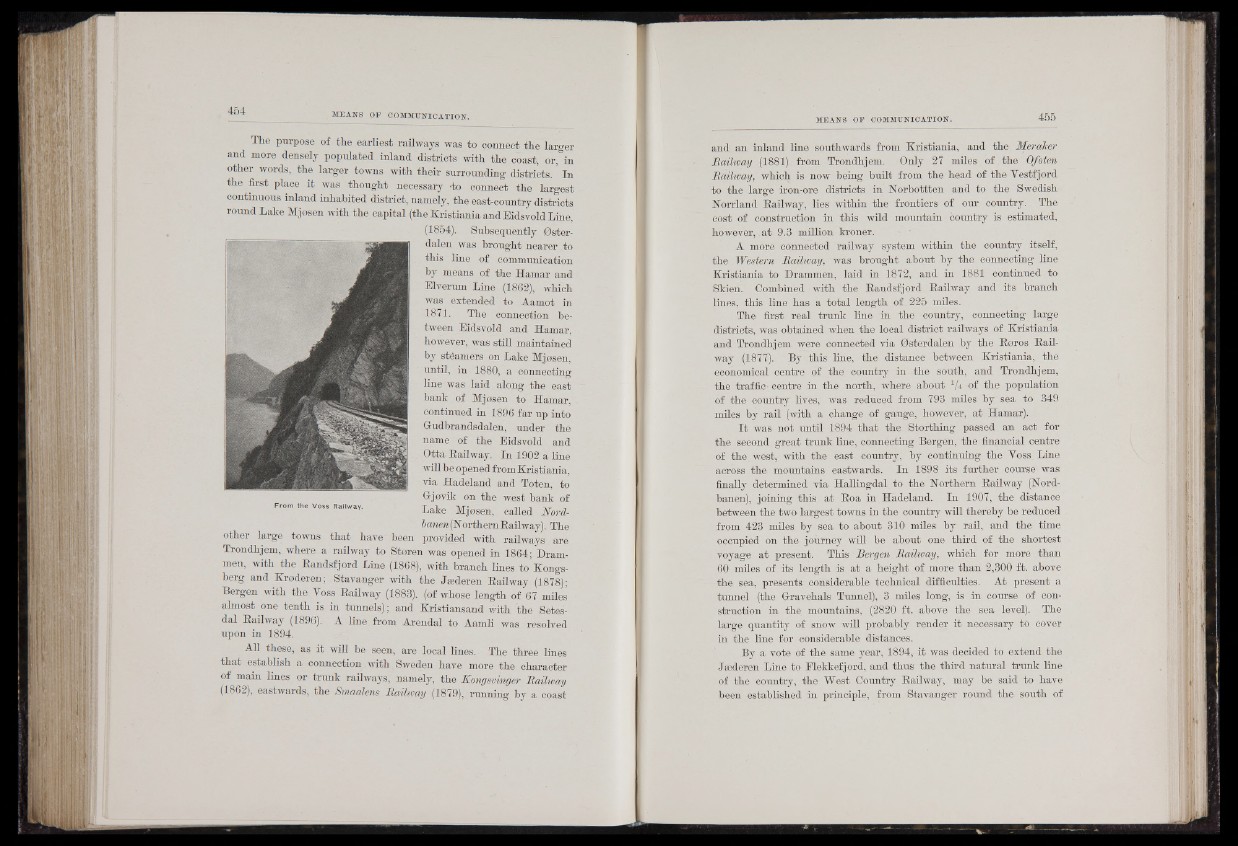
The purpose of the earliest railways was to connect the larger
and more densely populated inland districts with the coast, or, in
other words, the larger towns with their surrounding districts. In
the first place it was thought necessary to connect the largest
continuous inland inhabited district, namely, the east-country districts
round Lake Mjesen with the capital (the Kristiania and Eidsvold Line,
(1854). Subsequently 0ster-
dalen was brought nearer to
this line of communication
by means of the Hamar and
Elyerum Line ' (1862), which
was extended to Aamot in
1871. The connection between
Eidsyold and Hamar,
however, was still maintained
by steamers on Lake Mjosen,
until, in 1880, a connecting
line-was laid along the east
bank of Mjosen to Hamar,
continued in 1896 far up into
Gudbrandsdalen, under the
name of the Eidsvold and
Otta Railway. In 1902 a line-
will be opened from Kristiania,
via Hadeland and Toten, to
Gjovik on the west bank of
Lake Mjosen, called Nord-
banen(NorthernRailway). The
other large towns that have been provided with railways are
Trondhjem, where a railway to Staren was opened in 1864; Dram-
men, with the Randsfjord Line (1868), with branch lines to Kongs-
berg and Kroderen; Stavanger with the Jsederen Railway (1878);
Bergen with the Yoss Railway (1883), (of whose length of 67 miles
almost one tenth is in tunnels); and Kristiansand with the Setes-
dal Railway (1896). A line from Arendal to Aamli was resolved
upon in 1894.
All these, as it will be seen, are local lines. The three lines
that establish a connection with Sweden have more the character
of main lines or trunk railways, namely, the Kongsvmger Railway
(1862), eastwards, the Smaalens Railway (1879), running by a coast
and an inland line southwards from Kristiania, and the Meraher
Railway (1881) from Trondhjem. Only 27 miles of the Ofoten
Railway, which is now being built from the head of the Vestfjord
to the large iron-ore districts in Norbottten and to the Swedish
i t orr land Railway, lies within the frontiers of our country. The
cost of construction in this wild mountain country is estimated,
however, at 9.3 million kroner.
A more connected railway system within the country itself,
the Western Railway, was brought about by the connecting line
Kristiania to Drammen, laid in 1872, and in 1881 continued to
Skien. Combined with the Randsfjord Railway and its branch
lines, this line has a total length of. 225 miles.
The first real trunk line in the country, connecting large
districts, was obtained when the local district railways of Kristiania
and Trondhjem were connected via 0sterdalen by the Roros Railway
(1877f§ By this line, the distance between Kristiania, the
economical centre of the country in the south, and Trondhjem,
the traffic- centre in the north, where about 1U of the population
of the country lives, was reduced from 793 miles by sea to 349
miles by rail (with a change of gauge, • however, at Hamar).
I t was not until 1894 that the Storthing passed an act for
the second great trunk line, connecting Bergen, the financial centre
of the west, with the east country, by continuing the Yoss Line
across the mountains eastwards. In 1898 its further course was
finally determined via Hallingdal to the Northern Railway (Nord-
banen), joining this at Roa in Hadeland. In 1907, the distance
between the two largest towns in the country will thereby be reduced
from 423 miles by sea to about 310 miles by rail, and the time
occupied on the journey will be about one third of the shortest
voyage at present. This Bergen Railway, which for more than
60 miles of its length is at a height of more than 2,300 ft. above
the sea, presents considerable technical difficulties. At present a
tunnel (the G-ravehals Tunnel), 3 miles long, is in course of construction
in the mountains, (2820 ft. above the sea level). The
large quantity of snow will probably render it necessary to cover
in the line for considerable distances.
By a vote of the same year, 1894, it was decided to extend the
Jiederen Line to Elekkefjord, and thus the third natural trunk line
of the country, the West Country Railway, may be said to have
been established in principle, from Stavanger round the south of